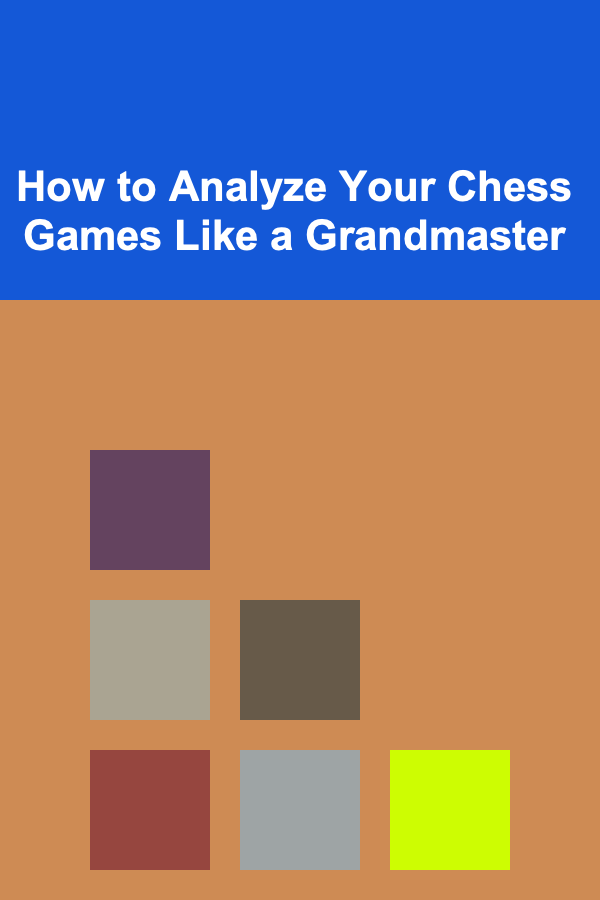
How to Analyze Your Chess Games Like a Grandmaster
ebook include PDF & Audio bundle (Micro Guide)
$12.99$10.99
Limited Time Offer! Order within the next:

Chess is an intellectual battle that requires strategy, foresight, and understanding. While winning is the goal, analyzing your chess games is just as crucial for improvement. Many players, from beginners to advanced, struggle with understanding how to properly assess their games and identify critical moments. Grandmasters (GMs) have developed specific methods and frameworks for analyzing their games, and you can apply these same techniques to level up your chess skills.
In this article, we will take you through the step-by-step process of analyzing your chess games like a grandmaster, revealing the tools, mindset, and strategies that elite players use to understand their games deeply and improve.
Understanding the Importance of Game Analysis
For any chess player, whether you're a beginner or an experienced player, analyzing your games is one of the most effective ways to improve. Here's why it's so important:
- Identify Mistakes and Weaknesses: By reviewing your games, you can pinpoint where things went wrong and what you can do to avoid similar mistakes in the future.
- Learn from Your Opponent: Even if you lose, there is always something to learn from your opponent's strategy. Studying their moves can provide insights into tactics, strategies, and positioning you may not have considered.
- Enhance Pattern Recognition: The more you analyze, the better you get at recognizing typical patterns, tactical motifs, and strategic ideas.
- Improve Decision-Making: Analyzing your decisions during the game helps you understand why you made a certain move and how to improve your decision-making process.
The Grandmaster's Approach to Game Analysis
A grandmaster's analysis approach is methodical, structured, and thorough. Here's a breakdown of how they analyze games:
Step 1: Review the Game Without Assistance
After finishing a game, the first thing a grandmaster does is review the game without using a chess engine. This is a vital step to ensure they are thinking critically about their own moves and the decisions they made. It's easy to rely on engines too soon, but this prevents you from gaining a deeper understanding of your own thinking process.
- Focus on Key Moments: Identify the critical moments in the game, such as when the advantage shifted or when a mistake was made.
- Reflect on Your Strategy: Consider the opening, your middlegame ideas, and your endgame plan. Did they work as expected? Were there moments you deviated from your plan, and if so, why?
Step 2: Find the Critical Moments
Grandmasters focus on critical moments in a game --- those points where the balance of the game changes, either positively or negatively. These moments often occur after a mistake or a brilliant idea.
- Key Moments to Watch For :
- A miscalculation or blunder.
- A missed tactical opportunity.
- A critical decision that impacts the flow of the game (such as exchanging pieces or changing the pawn structure).
- Critical Thinking : Once you identify these moments, ask yourself:
- Why did I make that move?
- Could there have been a better move at that point?
- How did this decision affect the position later in the game?
Step 3: Check for Tactical Blunders and Missed Opportunities
Tactical blunders often turn the tide in a chess game. Analyzing these moments can help you avoid similar errors in the future.
- Common Blunders :
- Hanging pieces.
- Oversights in calculation (i.e., missing a check, capture, or threat).
- Underestimating an opponent's tactic.
- Missed Opportunities: Look for moments when you had the chance to gain material, achieve a strong position, or even checkmate. Did you overlook a tactic or miss a combination? Consider why you didn't see it --- was it because of time pressure, a lack of focus, or just a failure to calculate deeply?
Step 4: Evaluate the Endgame
If the game reaches an endgame, grandmasters pay close attention to the structure of the position and the types of plans available. The evaluation of endgame positions is crucial for finding out whether you're ahead or behind and determining the correct strategy.
- Assess Material Balance: Even if you're ahead in material, it's important to determine if your pieces are active or passive. A pawn advantage might not matter if the pieces are poorly placed.
- Simplify or Complicate: Based on the position, should you simplify the game (trading pieces to convert your advantage) or complicate it to pressure your opponent?
- Pawn Structures: Look at the pawn structure --- are there weaknesses you can exploit or advantages you can create?
Step 5: Analyze with a Chess Engine (After Initial Analysis)
Once you have reflected on the game and identified the critical moments, it's time to consult a chess engine. Tools like Stockfish or AlphaZero can analyze positions and give you insights into moves you might have missed.
- Identify Mistakes : Engines provide a clear indication of mistakes, inaccuracies, or suboptimal moves. However, avoid solely relying on them --- their evaluations should be used to augment your own analysis, not replace it.
- Study Engine's Suggestions: Once you've identified potential improvements, study the engine's recommended moves. What makes them better than your move? Does the engine offer a deeper tactical or strategic idea that you hadn't considered?
Recognizing Patterns and Improving Your Play
Grandmasters develop an intuitive sense of common patterns and motifs. You can start building your own understanding by recognizing common patterns in both tactical and strategic play.
Recognizing Tactical Patterns:
- Forks: One piece attacks two or more of the opponent's pieces.
- Pins: A piece cannot move because doing so would expose a more valuable piece to attack.
- Skewers: A more valuable piece is attacked, and when it moves, a less valuable piece is attacked.
- Discovered Attacks: A piece moves to reveal an attack by another piece.
Recognizing Strategic Patterns:
- Weak Squares: Identify squares that cannot be defended by pawns and are weak spots in your opponent's camp.
- Open Files: Control of open or semi-open files for rooks can provide strong attacking chances.
- Outposts: A piece (usually a knight) placed on a square that is supported by pawns and cannot be easily displaced.
Applying the Analysis to Future Games
Once you've analyzed your games, it's time to put your insights into practice. Here's how grandmasters apply their analysis to their future games:
Incorporating Improvements into Your Opening Repertoire
After analyzing your games, you may notice weaknesses in your opening or transitions into the middlegame. Adjust your opening repertoire to avoid common mistakes or traps.
Focusing on Specific Areas of Your Play
If you repeatedly find mistakes in a particular phase of the game --- such as tactics or endgames --- make that area a focus of your study. Books, videos, and puzzles can help you sharpen your skills in these areas.
Monitoring Your Progress
As you continue to analyze your games and practice, track your progress. Are you making fewer mistakes? Are you winning more games in your preferred opening? Consistent analysis and reflection will result in noticeable improvement over time.
Final Thoughts
Analyzing chess games like a grandmaster is a skill that takes time to develop. By focusing on critical moments, understanding mistakes and missed opportunities, and using chess engines as tools, you can improve your game significantly. Grandmasters don't just look for mistakes; they explore the deeper reasons behind their decisions, evaluate key patterns, and systematically apply lessons to future games.
Chess is a journey of continuous learning and improvement. The more you analyze, the more you'll deepen your understanding of the game and sharpen your tactical and strategic thinking. Keep reviewing your games, keep questioning your moves, and, above all, enjoy the process of growth and mastery.
By applying these techniques, you'll soon be well on your way to thinking like a grandmaster and improving your chess results. Whether you're a competitive player or someone who just loves the game, analyzing your games thoroughly is one of the best ways to evolve as a chess player.
Reading More From Our Other Websites
- [Gardening 101] DIY Mulch Mixes: Combining Organic Materials for Maximum Benefits
- [Personal Financial Planning 101] How to Choose the Right Health Insurance Plan for Your Needs
- [Organization Tip 101] How to Choose the Right Furniture for an Organized Workspace
- [Home Rental Property 101] How to Handle Tenant Inquiries for Your Houses for Rent with a Guest House and Streamline the Application Process
- [Organization Tip 101] How to Use Repurposed Materials for Yard Sale Displays
- [Personal Investment 101] What is a Roth IRA and Why It's a Smart Choice for Your Retirement
- [Personal Care Tips 101] How to Choose the Best Face Mask for Your Skin Type
- [Home Space Saving 101] How to Use Multi-Functional Furniture for Maximum Space Savings
- [Personal Care Tips 101] How to Get Rid of Post-Shave Irritation with Aftershave
- [Home Space Saving 101] How to Maximize Storage in Small Bedrooms with Creative Solutions

How to Create a Checklist for Performance Improvement Action Plans
Read More
How to Set Up a Cozy Sleeping Area for Your Pet
Read More
How to Use QR Codes for Easy Access to Travel Information
Read More
How to Explore Crypto for Supply Chain Traceability
Read More
How to Plan for Q&A in Your Public Speaking Presentation
Read More
How to Master Your Nursing Entrance Exam To-Do List
Read MoreOther Products

How to Create a Checklist for Performance Improvement Action Plans
Read More
How to Set Up a Cozy Sleeping Area for Your Pet
Read More
How to Use QR Codes for Easy Access to Travel Information
Read More
How to Explore Crypto for Supply Chain Traceability
Read More
How to Plan for Q&A in Your Public Speaking Presentation
Read More